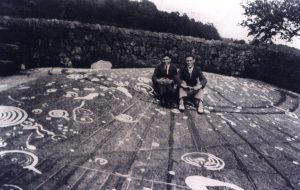5,000-year-old star map from a lost advanced civilization

 One of the fascinating archaeological mystery is the discovery of the so-called Cochno stone.
One of the fascinating archaeological mystery is the discovery of the so-called Cochno stone.
Discovered in 1887 by the Rev. James Harvey, the ancient stone measures 13 meters by 7.9 and features around 90 intricate carvings—considered as one of the finest sets of petroglyphs in Scotland—which according to many researchers represent a cosmic map, detailing planets and stars.
The 5,000-year-old ‘Cochno Stone’ contains around 90 intricate spirals and intentions that according to some authors, represent an ancient cosmic map.
Discovered in 1887, the mystery stone remained buried for decades in order to protect it from vandalism. The Cochno Stone in West Dunbartonshire bears what is considered to be the finest example of Bronze Age “cup and ring” carvings in Europe.
Later, the stone brought media attention and soon visitors came flocking. Over the next couple of decades, their numbers kept increasing as urban Glasgow crept closer.
By the early 1960s, the Cochno stone had become a popular place for local people and children to hang out. There was a growing fashion for visitors to carve marks and names into the soft rock, and lots of people were walking on the surface.
In 1964, Glasgow University archaeologists recommended it should be buried under several feet of soil to protect the carvings from further damage by vandals. The stone has been covered ever since.
Straddling the garden of a private property and parkland owned by the local council, it is now covered by vegetation and surrounded by trees.
In his book The Prehistoric Rock Art of Southern Scotland, archaeologist Ronald Morris, an expert in ancient rock carvings, described the stone as “one of Scotland finest collections of petroglyphs”.

The re-excavation also revealed 19th- and 20th-century graffiti etched alongside the swirls, as well as painted lines intentionally made by an archaeologist named Ludovic Maclellan Mann, who worked at the site in 1937. Mann painted lines on the Cochno Stone to help measure the prehistoric artwork and see if there was a link to astronomical phenomena, such as eclipses.
Mann “was trying to prove that the symbols could predict eclipses and were marking movements of the sun and moon in prehistory,” said Kenny Brophy, an archaeologist and senior lecturer at the University of Glasgow.
He said that Mann’s own data ended up disproving the archeologist’s theory.
Then as now, there is no consensus among archaeologists as to what the symbols meant to those who carved them. Explanations range from tribal symbols and territorial markers to maps, representations of the stars, and even containers for liquids used in rituals. Similar sites appear across northern Europe, though this is one of the most extensive.




